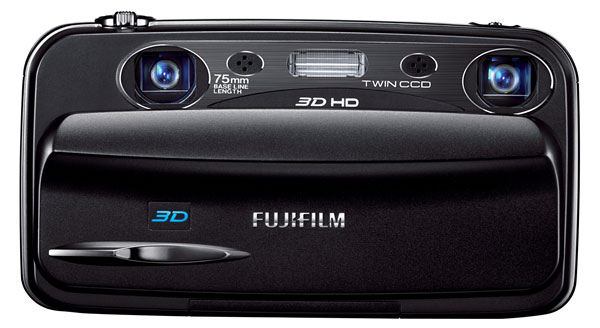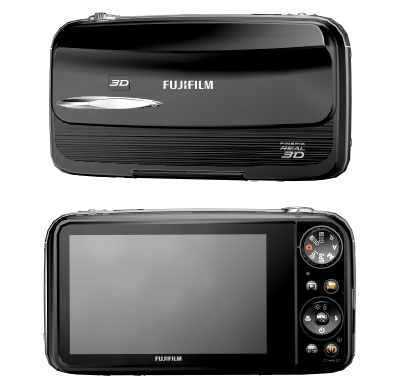 Fujifilm announced a new 3D digital camera today, the FinePix REAL 3D W3 digital camera. I had the opportunity to see the W3 a week before its official release. I had hoped to actually touch and make some 3D stills and video with the camera. Unfortunately, that opportunity did not present itself. Instead, I sat down in front of a 3D-capable television while a Fujifilm product representative explained the 3D market space and how they expect 3D technology to catch on. According to the Fujifilm rep, 1.2 million 3D-capable televisions are expected to sell in the next year. After the market space was explained a demo of the new Fujifilm W3 3D camera commenced.
Fujifilm announced a new 3D digital camera today, the FinePix REAL 3D W3 digital camera. I had the opportunity to see the W3 a week before its official release. I had hoped to actually touch and make some 3D stills and video with the camera. Unfortunately, that opportunity did not present itself. Instead, I sat down in front of a 3D-capable television while a Fujifilm product representative explained the 3D market space and how they expect 3D technology to catch on. According to the Fujifilm rep, 1.2 million 3D-capable televisions are expected to sell in the next year. After the market space was explained a demo of the new Fujifilm W3 3D camera commenced.
I put on some Sony powered 3D glasses and viewed the Sony 3D television while the W3 was connected via HDMI and some in-camera imagery was demoed. I immediately started to think about how I could frame a photo in some wide, dramatic location that would return the viewer to the days of View-Master 3D images I remembered looking at as a kid. Unfortunately, the demo was not a hands-on experience and I walked out of the 30-minute presentation disappointed.
About The Fujifilm W3 3D Digital Camera:
In 2009, Fujifilm introduced the first dedicated 3D digital camera. The new Fujifilm FinePix REAL 3D W3 digital camera was also designed specifically for 3D photography and video. It uses two 35-105mm Fujinon lenses and two CCD sensors to capture 720p HD 3D videos or still images. The Fujifilm W3 3D camera is compelling in its ability to easily create 3D still photos as well as 3D video that can be shared directly from the camera on a compatible 3D TV set. I was more interested in the W3′s 3D video abilities since I think making 3D videos would be more interesting than stills. The camera also has a 2D mode where the camera can use each lens independently. For instance, you can simultaneously take zoomed-in and wide-angle photos. I am not sure how useful that would be but I have never seen that ability before and it got me thinking about other ways you could use a two-lens camera. One idea – you could use each lens independently to create an HDR image from two bracketed, simultaneously captured images.
The difficulty of capturing, sharing, and viewing 3D images has greatly limited the appeal of 3D photography. It appears Fujifilm is trying to change that with the W3. In theory the W3 makes creating 3D images easier but since I did not have the opportunity to create my own 3D photos, I still do not know. One of the biggest challenges I see with the Fujifilm W3 (and 3D cameras in general) is that there isn’t a clear and easy way to share the 3D imagery. Television makers are expecting to sell over a million 3D televisions in the next year and Fujifilm is obviously trying to ride that wave. However, I am not running out anytime soon to purchase a 3D-capable television. And nobody I know is either. For 3D cameras to succeed, I think we need a Web-based 3D image-sharing platform. Even then there’s still the issue of special 3D glasses for viewing the images. An alternative would be making 3D printing, such as lenticular printing, (remember the Cracker Jack prizes that showed simple 3D and motion effects like winking eyes or a baseball player swinging a bat) more accessible to consumers.

Stereoscopy & Other 3D Imaging Options
Traditionally known as Stereoscopy, the ability to create 3D photography is nothing new. The handheld Stereopticon 3D viewer dates back to the 1800s. Between 1840 and 1910 millions of 3D photos were taken!
The new digital 3D digital cameras are getting a lot of attention. But you can use almost any camera to create 3D images. The most common way to capture 3D images is to use two linked cameras. Another possibility is a special lens that captures two images with a single shutter release. I expect that other camera manufactures are headed this direction using add-on’s to existing cameras. Panasonic has already announced a 3D digital camcorder with a 3D adapter lens as well as a 3D adapter lens for their Micro Four Thirds system cameras.
I always like the ability to go low budget and use equipment I already own. One technique that has come to my attention recently is called “wiggle stereoscopy.” Basically, you take a few photos of a subject, shifting the camera slightly for each frame. Then you use software to create an animation of the two images flipping back and forth like a flipbook. That animation replicates the 3D effect you get from two separate images and a 3D viewing device like the View-Master or Stereopticon. What I like most about this method is that anyone with any camera can make stereoscopic photos. Below are some wiggle stereoscopy examples I found on the Web.
San Francisco-based artist Joshua Heineman is taking the vintage approach, using old stereographs he finds at the New York Public Library. When these images were first captured they would be viewed using a stereoscope, but Heineman converts them into animated GIFs. The following series is called “Reaching for the Out of Reach.”
http://lala.cursivebuildings.com/tagged/reaching
There are even some who are making wiggle videos:
If you want to create a simple two-image animated GIF like the ones Martinez makes, here is a program that makes it easy.
http://stereo.jpn.org/eng/stphmkr/index.html
The new Fujifilm FinePix REAL 3D W3 digital camera will be available in September for just under $500.
-Robert Burns
www.dollop.com
Fujifilm FinePix REAL 3D W3 Digital Camera Press Release
Fujifilm FinePix REAL 3D W3 Digital Camera Specifications
Related Content:
All Fujifilm User Reviews
All Digital Camera User Reviews
Digital Cameras Forum
More Fujifilm News, Reviews and Articles
Fujifilm Web Site



Where can I find this awesome camera in south africa. I am currently in Durban